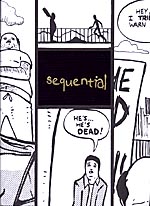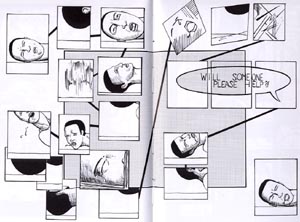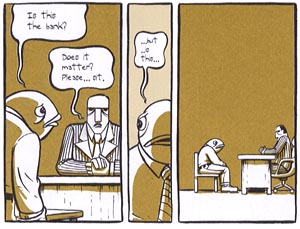 By Paul Hornschemeier
By Paul Hornschemeier
256 pages, black and white, with two-color
Published by AdHouse Books
Think back to the first time you tried to do something that requires talent, something that over the years you’ve improved at greatly. Are you cringing? That’s a reaction that most of us have; when you’ve gotten good at something, it’s tough to look back at those earlier, faltering steps. I think that’s what initially intrigued me so much about the new Sequential hardback collection. Paul Hornschemeier’s comics like Mother, Come Home and Return of the Elephant completely enchanted me, so a chance to see his earliest self-published book made me wonder: was Hornschemeier always this good?
 In the earliest of Sequential‘s seven issues, it’s safe to say that Hornschemeier’s comics were pretty different from what they’d ultimately become. The book was a lot of one- and two-page jokes, letting people wait for the final punchline. Even in those earliest stories, though, Hornschemeier had begun to play with style and form. There’s a story from Sequential #2, for instance, which opens with a two-page sequence of a man having a seizure. Hornschemeier scatters panels across the page, each connected to another one in a web of lines. It jerks the reader’s eyes from one spot to the next, and helps simulate the idea of a seizure in a clever and effective way. (The story then ultimately ends, like the rest of the early stories, with a punchline.) Hornschemeier’s art at this stage was full of much thinner lines than what I’m used to now; it’s a style that attempts to be much more detailed than what Hornschemeier uses now, but at the same time it manages to somehow look simpler at the same time.
In the earliest of Sequential‘s seven issues, it’s safe to say that Hornschemeier’s comics were pretty different from what they’d ultimately become. The book was a lot of one- and two-page jokes, letting people wait for the final punchline. Even in those earliest stories, though, Hornschemeier had begun to play with style and form. There’s a story from Sequential #2, for instance, which opens with a two-page sequence of a man having a seizure. Hornschemeier scatters panels across the page, each connected to another one in a web of lines. It jerks the reader’s eyes from one spot to the next, and helps simulate the idea of a seizure in a clever and effective way. (The story then ultimately ends, like the rest of the early stories, with a punchline.) Hornschemeier’s art at this stage was full of much thinner lines than what I’m used to now; it’s a style that attempts to be much more detailed than what Hornschemeier uses now, but at the same time it manages to somehow look simpler at the same time.
As the series progresses, though, each issue gets a little stronger and more intriguing. Sequential #4, for instance, has the bleak and somewhat disturbing “Saving Face” with its glimpse into one person’s day and the literal mask they wear; the black comedy of “Lover’s Lane” as people perform a ritual that will keep them together; and “Let’s Play Gay or Straight”, Hornschemeier’s deeply cynical look at assumptions and bigotry. None of these are meant to illicit a laugh like some of the earlier issues, and Hornschemeier’s starting to find his own unique voice in his writing.
By the seventh and final issue of Sequential, Hornschemeier had started two serials that are unfortunately never completed. “The Devil’s Lonely Day” is one that actually requires the serialized format to have it realize its full impact; it’s told in three six-page installments, but the first installment featured pages 1, 4, 7, 10, 13, and 16. The idea was that you could read each group of pages on its own and they would make sense, but if you resequenced all eighteen pages together it would work as well. It’s a fascinating experiment, and while the first two segments certainly work, it’s frustrating to never get that third and final group of pages to see just how they fit into the story as well.
The other serial, “The Suppression of William T. Andrews”, intrigues me in part because of its unfinished nature. The story of a boy who due to society’s pressures hides a part of his nature starts first with his life as a child, then as a young man. Seeing the changes that have happened between those years is interesting, and wondering what would happen next after a sudden confrontation is a little frustrating, but at the same time it lets you really think about the character’s life, someone who like in real life has dropped off of your radar and left you in the dark as to their own whereabouts.
 “Ex Falso Quadlibet” is probably the closest in style and form to what Hornschemeier is producing today, telling the story of a fish-headed man who is feeling the vacancy of a loved one that’s gone away. It’s an ode to loneliness and patterns that we fall into, and a lot of the genesis of Hornschemeier’s later projects seems to come from the thoughts and ideas raised here. It’s also the closest visually to Hornschemeier’s current works, using different shades of a second colored ink to provide a gentle contrast on the page. By this point Hornschemeier’s lines have developed a rounded softness that helps disarm the reader, making them more vulnerable to the emotional weight of the story.
“Ex Falso Quadlibet” is probably the closest in style and form to what Hornschemeier is producing today, telling the story of a fish-headed man who is feeling the vacancy of a loved one that’s gone away. It’s an ode to loneliness and patterns that we fall into, and a lot of the genesis of Hornschemeier’s later projects seems to come from the thoughts and ideas raised here. It’s also the closest visually to Hornschemeier’s current works, using different shades of a second colored ink to provide a gentle contrast on the page. By this point Hornschemeier’s lines have developed a rounded softness that helps disarm the reader, making them more vulnerable to the emotional weight of the story.
Sequential is a fascinating study in a creator’s progress. It’s rare to see someone’s learning process so thoroughly documented as Sequential is for Hornschemeier, and how interesting looking at that road can be. It’s a handsome book chronicling the creations of one of comics’s most interesting young creators, and if this sounds interesting to you, then you’ll be just as delighted with Sequential as I was.
Purchase Links:
